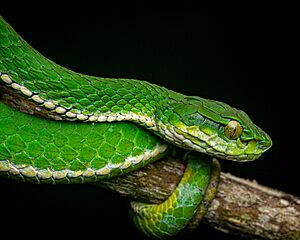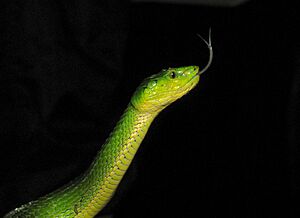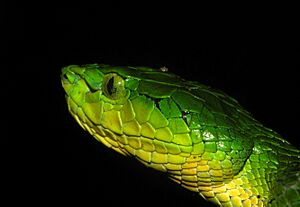Large-scaled pit viper facts for kids
Quick facts for kids Large-scaled pit viper |
|
|---|---|
 |
|
| Conservation status | |
| Scientific classification | |
| Genus: |
Craspedocephalus
|
| Species: |
macrolepis
|
| Synonyms | |
|
|
The large-scaled pit viper (scientific name: Craspedocephalus macrolepis) is a type of venomous pit viper. It lives only in the mountains of southern India. This snake is special because it has very large scales. No different types (subspecies) of this snake are known.
Contents
Where It Lives: Geographic Range
This pit viper is found in the mountains of the southern Western Ghats. These mountains are in the Indian states of Kerala and Tamil Nadu. It prefers to live in high places. You usually won't find it below 1,200 meters (about 3,900 feet) above sea level.
Some specific places where it has been seen include Nelliyampathy, Munnar, and Anaimalai. It also lives in the Palni hills, Meghamalai, and Periyar Tiger Reserve. You can find it in the Agasthyamalai and Kalakkad Mundanthurai Tiger Reserve too. These areas are all at high elevations, from 1,200 to 2,695 meters (about 3,900 to 8,800 feet). The first place this snake was officially found was the "Anamalai hills" in Tamil Nadu.
What It Looks Like: Description
The large-scaled pit viper can grow to a good size. Its body length includes a tail that is about 12 centimeters (5 inches) long.
This snake is usually bright green on its back. Sometimes, you can see black skin between its scales. It has a yellow or white stripe on each side of its body. This stripe runs along the first row of scales. Its upper lips are light green. Sometimes, there is a black line behind its eye.
The scales on its back are large and overlap each other. They are arranged in 12 to 15 rows around the middle of its body. The scales in the middle 10 rows are always the biggest. Other rows have smaller scales. It's interesting that this snake often has an even number of scale rows. This is not common for most snakes. It has 133 to 143 belly scales and 44 to 58 scales under its tail.
The scales on top of its head are very large and smooth. There is a long scale below its eye. This scale is separated from its upper lip scales by a few small scales. It has 7 or 8 upper lip scales, and the third one is the largest.
Where It Lives: Habitat
The large-scaled pit viper moves slowly. It spends a lot of time in trees. It is also active at night. This snake likes to live in rainforests. You can also find it in tea, coffee, and cardamom farms.
How It Behaves: Behavior
This snake can live both on the ground and in trees. It uses its prehensile tail to hold onto tree branches. It is an ambush hunter. This means it waits quietly for its prey. Its green color helps it blend in with its surroundings. This is called camouflage. It uses special heat-sensing pits on its face to find warm-blooded animals.
What It Eats: Diet
The large-scaled pit viper eats mostly frogs and lizards. It also hunts small birds and rodents.
About Its Venom
This snake's venom is thought to affect blood (a hemotoxin). However, it has not been studied very much. People who pick tea leaves are often bitten by this snake. But these bites are usually not deadly.
How It Reproduces: Life Cycle
The large-scaled pit viper lays eggs. Females that are old enough to have babies lay eggs in October. They usually lay between 4 and 7 eggs at a time.




